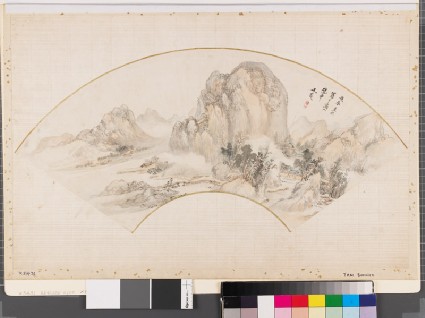Browse: 772 objects
Misty mountain landscape
-
Details
- Associated place
- Date
- 1808
- Artist/maker
-
Tani Bunchō (1763 - 1841) (artist)Shazanrō Studio (active c. 1800 - 1860)Nanpin School (active 1731 - 19th century)
- Material and technique
- ink, colour, and gold on paper
- Dimensions
-
mount 36.5 x 55.5 cm (height x width)
painting 24.7 x 52.5 cm (height x width)
- Material index
- Technique index
- Object type index
- No. of items
- 1
- Credit line
- Presented by Dr Michael Harari, from the collection of his father, Ralph Harari, 1981.
- Accession no.
- EAX.5431
-
Further reading
Katz, Janice, Japanese Paintings in the Ashmolean Museum, Oxford, with an introductory essay by Oliver Impey (Oxford: Ashmolean Museum, 2003), no. 10 on pp. 64-65, p. 39, illus. p. 65
Hillier, J., The Harari Collection of Japanese Paintings and Drawings, copyright owned by Michael Harari, 3 vols (London: Lund Humphries, 1973), cat. non. 303 on p. 538, illus. p. 537 fig. 303
Location
-
- currently in research collection
Objects are sometimes moved to a different location. Our object location data is usually updated on a monthly basis. Contact the Jameel Study Centre if you are planning to visit the museum to see a particular object on display, or would like to arrange an appointment to see an object in our reserve collections.
Publications online
-

Japanese Paintings in the Ashmolean Museum
A landscape coloured with soft blue, green and orange is dominated by a tall mountain just right of centre. On either side of the mountain, mist serves to soften the transition into the next vignette. To the right, a temple is nestled among the trees, and on the left a scholar is followed by a servant carrying a qin across a bridge that spans an expanse of water. A cluster of trees are rendered in the foreground in front of the mountain, some with lush foliage and others with bare branches, each one distinct. Using a limited palette of colours, as well as the colour of the paper for the mist. Bunchō here is able to describe a variety of textures and solid, three-dimensional forms. He has created an entire world on this one small fan, even the monumental mountain stays well within the bounds of the format.
Tani Bunchō was a cultural force in Edo period Japan as a painter, teacher, surveyor and connoisseur. He was a prolific artist, able to paint equally skilfully in several styles, and is hailed in Japan as the master of eight different methods of painting. He studied both Northern and Southern school Chinese paintings, as well as Tosa school methods and Western style painting, not to mention sketching true landscapes and creatures from life. Bunchō received greatest acclaim as a painter of landscapes, and is credited with bringing the Nanga style to Edo. While young, Bunchō studied with Katō Bunrei (1706-1782), a Kano school artist, before turning to Southern and Northern style Chinese painting with Nakayama Kōyō (1770-1780) and flower and bird painting in the Chinese manner under Watanabe Gentai (1749-1822), an artist from Nagasaki. But perhaps the person who had the greatest influence on Bunchō was Matsudaira Sadanobu (1758-1829) [on Sadanobu’s activities, see Timon Screech, The Shogun's Painted Culture: Fear and Creativity in the Japanese States 1760-1829 (London: Reaktion, 2000).], the shogun’s regent. In 1792, Bunchō came into his employ [this relationship may have developed because Sadanobu was a member of the Tayasu family for whom Bunchō’s father was a retainer.], and was ordered to embark on making sketches of Chinese paintings and other antiquities throughout Japan, many of which were hidden from the public, resulting in the publication of Shūko jusshū (Ten Varieties of Collected Antiquities) in 1800.
The atelier Bunchō ran at the peak of his career was filled with students and admirers. He is said to have begun the vogue for calligraphy and painting meetings in Edo when he and his students met to discuss their work. Bunchō’s careful teaching methods had distinct steps: he would begin by having a pupil copy works by Chinese masters, then have them sketch from life, and only then were they encouraged to develop their own style. [See Kōno Motoaki, ‘Kyōikusha to shite no Bunchō’, in Tochigi Prefectural Museum of Fine Art, Shazanrō Tani Bunchō (Tochigi: Tochigi Prefectural Museum of Fine Art. 1979) and Frank Chance ‘In the Studio of Painting Study: The Transmission of Practices of Tani Bunchō’, In Brenda G. Jordan and Victoria Weston (eds), Copying the Master and Stealing his Secrets (Honolulu: University of Hawai’i Press, 2003), 60-85.]
It was with Watanabe Gentai that Bunchō began to be exposed to original Chinese paintings. Gentai owned twelve paintings by late Ming artist Lan Ying (1585-c. 1648), which Bunchō copied. During his lifetime, Bunchō produced many landscape paintings based on the composition of a foreground cluster of trees backed by a tall mountain, which is an interpretation of works by artists such as Lan Ying and Dai Jing’an, as seen here. [On the influence of Lan Ying on Bunchō, see Kōno Matoaki, ‘Bunchō and Lan Ying’, Yamato Bunka 105 (May 2001), 1-10. For Dai Jing’an see Khan Trinh. ‘In Pursuit of Ancient Styles: Tani Bunchō’s Viewing the Waterfal. After Dai Jing’an’, Orientations (Oct. 2000), 90-95]. Many of his hanging scroll compositions have a dominant verticality that the format allows, but here Bunchō has adapted that to a fan composition. Compared to later works, this image is carefully and slowly rendered, less dynamic than the ‘karasu’ Bunchō style he would embark on shortly after this image, but beautifully fabricated. The soft colours here are characteristic of those favoured by Bunchō at this point in his career. [For another example of a painting from this period with this colouring, see Kōno Motoaki, Tani Bunchō, Nihon no bijutsu no. 257 (Tokyo: Shibundō, 1987), plate 15].
© 2013 University of Oxford - Ashmolean Museum

